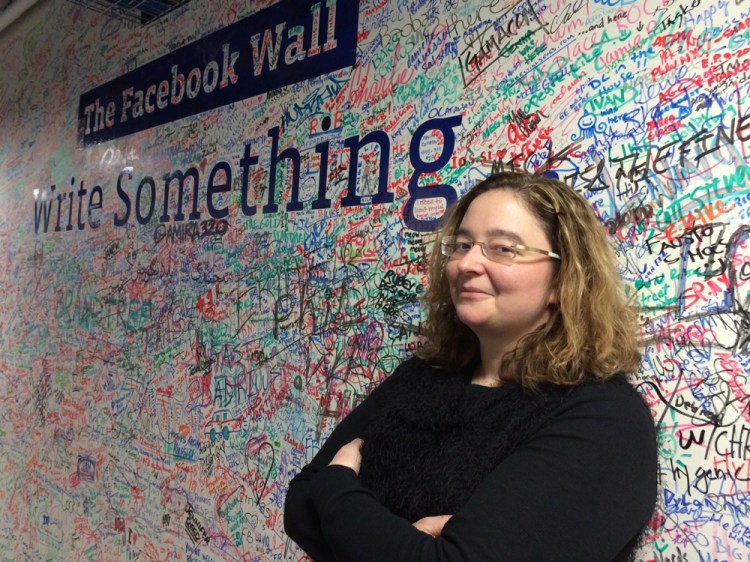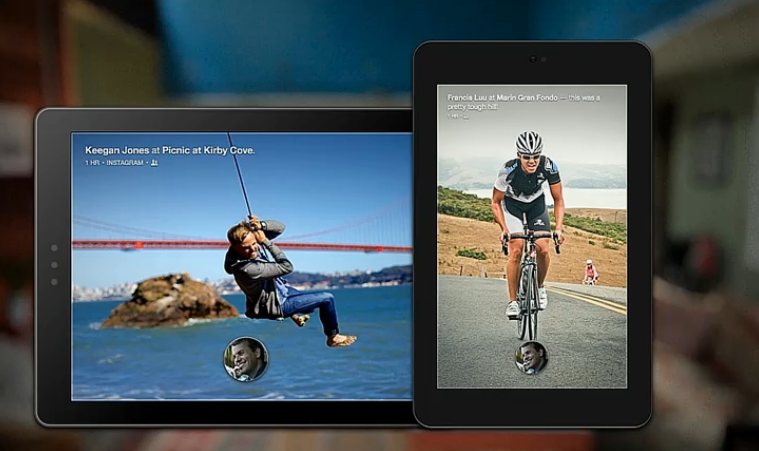Want smarter insights in your inbox? Sign up for our weekly newsletters to get only what matters to enterprise AI, data, and security leaders. Subscribe Now
NEW YORK CITY — Facebook isn’t blind to the problems it’s had on mobile.
The social network famously backtracked from its early decision to build HTML5-powered apps, and its overhyped Facebook Home Android skin hasn’t really gone anywhere. But according to Jocelyn Goldfein, an engineering director who joined the company in 2010, Facebook has learned from its past mistakes.
Apps like Paper show a new Facebook that can actually design something that’s beautiful. And notably, the company’s core mobile apps have dramatically improved over the past few years.
At Facebook’s New York City office, just a few blocks away from the main branch of the New York Public Library, Goldfein stopped by a few weeks ago to chat with the company’s local engineering team. I had a chance to chat with her before the presentation — check out our conversation below (edited for length and clarity).
VentureBeat: What are you focusing on for your talk with Facebook’s NYC team?
Jocelyn Goldfein: I’m going to talk about what the mobile ecosystem has meant for Facebook and vice versa. I think the main thing I want to do is share some lessons we’ve learned along the way. What Facebook is trying to do on mobile is of a size and scale that’s pretty unprecedented; there’s no real textbook.
I think it’s pretty well documented that we were not very good at mobile — terrible, in fact. … We had to learn, [and we were] definitely under the microscope.
The talk is about some of the mistakes we made and what we learned.
VentureBeat: Can you list some of those mistakes?
Goldfein: The big thing we did wrong at the outset was that we wanted to approach mobile like it was a web end-point. We really wanted to take our style and speed, our habits from the web and modify as little as possible to land on mobile. It was just a backward approach.
What we learned to do is start with the [mobile] platform and make the best possible application for it and to the extent that the web has things that are useful to bring them over — but don’t start from the web and try to bring them over. Start from mobile, and take what’s good from the web.
One of those things that’s been very good is our ability to iterate rapidly, to experiment, test, try different forms and see what things work. There are just not nearly as many rich tools for doing that on mobile, and it’s just harder on mobile since the execution is entirely client-side. But we’ve built some rather good frameworks for doing it, and I’ve got some good examples of ways that’s helped us solve some quality and reliability issues.
Last summer, we made a pretty significant redesign of the navigation of the [main Facebook] app. The data we got from A/B testing actually told us that our first and favorite design was fatally flawed, and we can do better.
VentureBeat: What specifically was flawed?
Goldfein: It’s sort of ironic. We kind of invented the three horizontal bar menu [previously available on the left side of the Facebook app, which enabled you to access different Facebook features]. It has since kind of become a universal standard. We decided we wanted to get away from that. We switched to a status bar model where there’s one-tap access to the things you want [similar to Twitter’s mobile app design].
We found that when you were navigating between tabs, users in the test were spending less time in the News Feed. They were also liking and commenting on stories from their friends less. That meant that they were actually missing stories they would have liked to see.
We believe the reason for that is, under the old menu with the left-side drawer, anywhere you wanted to go you had to work your way back to News Feed to go somewhere else. … And we think that what was happening with this design, as news stories were coming in there was nothing to bring you back to the News Feed tab.
We thought about putting a badge on it, a red bubble [with numbers] like you’re seeing on other tabs. That solved the time spent problem right away, but we didn’t really like that design. I think there’s kind of covenant when users see a red bubble like that, it means there’s really a notification, so there’s something you need to see. But since your News Feed is always moving, there’s no precedent that we pop up a count of stories that you need to read.
So instead, what ended up with is something that just puts a subtle blue glow under the [News Feed] tab. … It’s fairly subtle, although if you’ve seen it, you’ve probably not consciously registered it. But it’s enough to hint to you that there’s something there to check out.
That’s an example of a problem where, if you didn’t have the capability to isolate a change and the reaction of users to it, you can take your product in the wrong direction and not realize it.
VentureBeat: The Paper app seems like a completely new way for approaching Facebook. Is that your vision for the future, or are you just experimenting?

Goldfein: I think one of the things that we’ve learned is that there’s only so much functionality you can put into any one application. And I think users have an expectation that the Facebook app is all about their News Feed and the core Facebook experiences.
We definitely are seeing the power of introducing additional apps from Facebook, which aren’t necessarily a subset of features from the Facebook app but which give you different ways to interact with your social graph and the content that’s out there.
Messenger is probably our most longstanding standalone app … it was born on the web in the context of a chat product, and I think the Messenger app really takes it to an SMS replacement/texting product.
VentureBeat: Do you have a sense of how the Messenger app is doing? I remember when it launched, it was cool and there was some very innovative stuff there, and all of that went to the main app.
Goldfein: I think we’ve wrestled with that, because the main app obviously has more users than any other app that exists. So it’s easy to say if I’m building a new feature, the place it’s going to get the maximum exposure is in the main Facebook app. … There have been times we’ve really emphasized doing our best work and innovating features on the main app.
But I think being in a standalone app lets you take more risks. It lets you maybe break old assumptions. It helps users think about the product in a different way. I think in the main app messaging still feels like chat. What people who use it tell us is that they’re not sure where [messages] are being delivered to — they imagine the person on the other end may see it the next time they log into Facebook on their computer. They’re not really sure it’s the same experience as texting.
Messaging is a great example of where unbundling it into a separate application can actually deliver a new kind of experience, a new kind of expectation for the people using it.
I think Paper is another really good example of that. … I just love the UI. I think it’s one of the most polished, beautiful things that Facebook has done. But it’s not just a News Feed consumption app. … We’ve always been thinking about how do we make the News Feed not just a place for entertainment, but a place where you have to go, where you don’t want to miss what’s coming through.
We’ve always understood that users receive different kinds of content in their feed. They receive updates and personal status from friends, but it’s also a place where people are connected to entities and interests. They follow VentureBeat. … And merging all of those together into one pipeline isn’t the best way to experience all those different types of content.
Paper is giving us another way to let you consume information, and it doesn’t have to be one-size fits all. I think there’s a lot of different ways to take a cut at the graph and the data that’s in it.
VentureBeat: Unlike the Messenger app, I can’t really see how the Paper interface can be translated to the core app.
Goldfein: I definitely think there are things the Paper team has done that are so good we should steal them. [Laughs] But I think the Paper team should make the Paper app amazing, and the main app team should make that amazing. We shouldn’t force consistency for the sake of consistency.
VentureBeat: How do you think Facebook is handling mobile now, compared to when you started.
Goldfein: I joined Facebook in the summer of 2010, and at that point Facebook’s mobile team was like four guys in the basement. [For the web] there was a News Feed team; there was a Messenger team; there was a Photos team. … Collectively there were 100 or 200 engineers building all of these features [for the web], and then you had this one tiny team that was trying to keep feature parity with all of that in the iOS app.
And I won’t even talk about how we were approaching Android because it was just embarrassing. Everything has changed.
Then we had our ill-fated [decision]: Wait we know how to solve this and instantly turn every one of those web developers into mobile developers, we’ll just go with an HTML5 app! Boom, we’re done, right? Only, wrong.

VentureBeat: Was there a particular reason you think the HTML5 apps just didn’t work?
Goldfein: I think our whole approach was wrong. I think we just came from a place of, hey we’ve got all these engineers and we’re building all these features, we want to move as fast as possible, so the best platform for us is to just reuse that code and just shoehorn the web onto that smartphone.
I don’t think we came from the place of thinking about the person who’s going to be using Facebook, and what’s the best experience we can give for them. I think if we started with that person-centric approach, we would just want o build the best possible experience we could for them. And I think that’s a native experience right now.
Having lived through the ’90s and early 2000’s, I don’t want to say that the web will never overtake native. It did on the desktop. … What I want to say is my guiding star is to put the human being at the center. And as long as I’m building the best experience I can possibly build for that person using Facebook, I know I’m doing the right thing.
If that means at some point down the line I may have to change platforms or technologies, that’s fine. The half-life of a codebase is two years anyway. We are constantly rewriting our codebase. … You’re constantly discovering better ways to do things, taking advantage of new capabilities, cleaning up code that gets crufty as you add more functionality.
Code that isn’t being modified is code that’s rotting. That’s just the nature of software engineering.
VentureBeat: What are you looking forward to in the next few years, in terms of development?
Goldfein: I think it’s going to be more diverse. For sure, tablets right now are growing like phones were growing three years ago, maybe even faster. I think there’s so much more we can do to deliver tablet-based experiences that are amazing.
Facebook Home is a really wonderful experience, but I think we’re still perfecting that, getting the right traction for that. It shows what’s possible when you deeply integrate into a platform in a way that you can’t necessarily do on iOS.
Wearables are going to come along, and you’re going to want to see Facebook on those. I actually think Windows isn’t down for the count; I think we’ll see Microsoft growing in share.
Last but not least, something that a lot of mainstream tech companies don’t really think about, but Facebook does, is emerging markets. We’re trying to connect every human being on the planet, so U.S. and Europe is just a small fraction. It’s actually Asia, Africa, and South America [with a ton of potential users], those folks are coming online with Android phones with limited device capabilities. But they’re also still using a ton of feature phones — one of the fasted growing device categories on Facebook.
I think the high-end will get higher and the low-end will get lower.
VentureBeat: What’s going on with Facebook Home? It launched with a lot of fanfare and had a lot of hopes behind it, but I’m not seeing much in the way of usage. Is there anything you’ve learned since the launch?
Goldfein: Oh, we’re learning a lot. We’re still very bullish on Home. We’re not done with Home. I think part of the problem is launching with such fanfare at [version] 1.0. No startup launching at 1.0 would get that much coverage.
I think it takes time, when you’re building something genuinely new and disruptive … it takes time to get it right. I think we did a really good job with the polish, which is part of why I think it got such almost fawning coverage at the outset. But I don’t know that we made it valuable to users from the outset.
In my experience — I’ve been a startup founder and worked on many 1.0 products in my career — 1.0 is the product where you are searching for that value proposition. We’re patient; we’re prepared to give it time. We’re believers in Home; we believe it’s going to be valuable for users. But it’s on us to cause that to happen.
But it’s not like we just need to market it better, or distribute it better. We actually are consciously not trying to do those things until we feel like we’ve really built something that’s really valuable.




